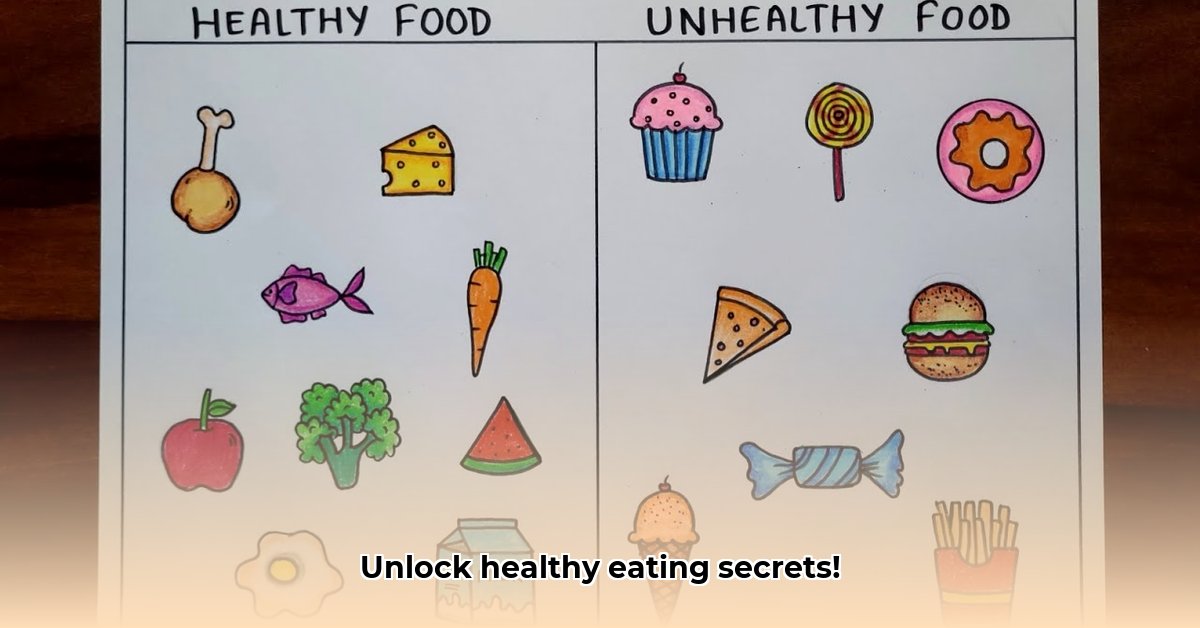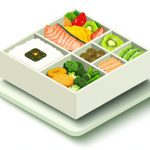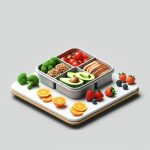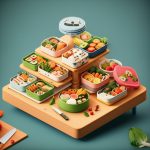Grocery shopping for healthy food doesn’t have to be a chore! This guide simplifies building a shopping list that’s beneficial for your health and your wallet. We’ll guide you through selecting the best fruits and vegetables, opting for lean proteins, and making informed decisions. Let’s embark on a journey towards healthier eating with straightforward steps and valuable advice.
Healthy Food Shopping List: Your Comprehensive Beginner’s Guide Incorporating Nutrient-Rich Foods
Navigating the grocery store for healthy food choices can be overwhelming, especially for beginners. Don’t worry! This guide empowers you to create a smart, healthy shopping list tailored to your budget and lifestyle. We’ll break down the process into manageable sections, simplifying healthy eating.
Produce Power: Maximizing Nutritional Value with Seasonal Picks
Let’s begin with the vibrant core of any healthy diet: produce. Purchasing fruits and vegetables in season is advantageous; they’re typically more affordable and flavorful, harvested at peak ripeness. Prioritize colorful produce to ensure a diverse intake of vitamins and minerals.
Consider fruits and vegetables with edible skins, like apples, berries, and cucumbers, for an extra nutritional boost and increased fiber intake. Remember to wash them thoroughly. Planning your weekly meals before shopping minimizes food waste, ensuring you only buy what you need. Storing produce properly extends its freshness.
Actionable Steps for Produce Perfection:
- Consult Seasonal Guides: Identify what’s in season in your region through online resources like the USDA Seasonal Produce Guide or local farmers’ market websites.
- Visit Farmer’s Markets: Explore local farmers’ markets for fresh, affordable produce and support local agriculture. Engage with farmers to learn about their practices.
- Compare Prices: Evaluate the price per pound of organic vs. conventional produce, making informed choices based on budget and priorities. Use the “Dirty Dozen” and “Clean Fifteen” lists to guide your decision.
- Start an Herb Garden: Easily grow fresh herbs like basil, mint, and parsley for added flavor at a fraction of the cost of pre-packaged options. Even a small windowsill garden can make a difference.
- Proper Storage: Store fruits and vegetables properly to extend their shelf life. For example, keep berries dry and store potatoes in a dark, cool place.
Protein Powerhouses: Fueling Your Body with the Right Choices
Lean protein is crucial for tissue repair, muscle building, and sustained energy. Excellent sources include chicken breast, turkey, and fish. Grass-fed meats and sustainably harvested seafood offer environmental and nutritional benefits, although they may be pricier. Plant-based proteins like beans, lentils, tofu, edamame, and chickpeas are affordable and nutritious alternatives. Frozen and canned proteins often provide similar nutritional value to fresh options and are typically more economical and convenient.
Pros and Cons of Protein Options:
| Protein Source | Pros | Cons |
|---|---|---|
| Lean Poultry (Chicken, Turkey) | Relatively inexpensive, readily available, versatile, good source of lean protein. | May contain higher sodium levels if processed. Choose skinless options. |
| Fish | Rich in Omega-3 fatty acids, promotes heart health, good source of Vitamin D. | Price varies based on type and availability; sustainability is a critical consideration. Check for mercury levels in certain fish. |
| Plant-Based Proteins | Versatile, high in fiber, generally affordable, good source of vitamins and minerals. | Preparation may be required for optimal taste and texture; protein content varies. Be mindful of complete protein sources or combining different sources. |
| Grass-fed Beef | Typically richer in nutrients (Omega-3s and CLA), more environmentally friendly (when sourced from responsible farms). | More expensive compared to other options. Can be higher in saturated fat depending on the cut. |
| Eggs | Inexpensive, versatile, excellent source of protein and choline. | Some people may have concerns about cholesterol content (though dietary cholesterol has less impact than previously thought). Choose pasteurized eggs for safety. |
| Greek Yogurt | High in protein, calcium, and probiotics. | Can be higher in saturated fat depending on the type. Choose plain, non-fat varieties to control sugar and fat intake. |
Actionable Steps for Protein Prowess:
- Compare Unit Prices: Check the price per pound or ounce before purchasing different protein options to make cost-effective decisions. Look for sales and discounts.
- Explore Cheaper Cuts: Experiment with less expensive meat cuts like chicken thighs or pork shoulder, unlocking delicious meals with creative recipes and slow cooking methods.
- Embrace Variety: Discover diverse plant-based proteins beyond tofu, opening a world of nutritious and flavorful options. Try tempeh, seitan, or a variety of beans and lentils.
- Consider Canned Fish: Canned tuna, salmon, and sardines are affordable and convenient sources of protein and omega-3 fatty acids. Choose options packed in water to reduce sodium.
- Plan Protein-Rich Meals: Incorporate protein into every meal to promote satiety and stable blood sugar levels.
Crafting Your Smart Healthy Shopping List for Optimal Nutrition and Budget
The following list provides a foundational template. Tailor it to your preferences, needs, budget, and dietary restrictions (e.g., gluten-free, vegetarian, vegan). Remember, flexibility is essential! Check for sales and use coupons to save money.
Produce Section:
- Seasonal fruits such as berries, apples, bananas, oranges, and kiwi.
- Seasonal vegetables such as broccoli, spinach, carrots, sweet potatoes, bell peppers and onions.
- Leafy greens like spinach, kale, or romaine lettuce.
Protein Powerhouse:
- Chicken breast or thighs, or drumsticks.
- Salmon or other sustainably sourced fish (canned or fresh).
- Lentils or chickpeas.
- Eggs.
- Greek yogurt (plain, non-fat).
- Tofu or tempeh (if plant-based).
Grains & Starches – The Energy Boosters:
- Whole-grain bread or rolls with minimal added sugars and high fiber.
- Brown rice or quinoa.
- Oats (rolled or steel-cut).
- Whole-wheat pasta or legume-based pasta.
Healthy Fats – The Flavor Enhancers:
- Avocado.
- Nuts and seeds (almonds, walnuts, chia seeds, flaxseeds).
- Olive oil (extra virgin).
- Nut butter (peanut, almond, or cashew).
Dairy/Alternatives – Calcium Power:
- Greek yogurt (plain, non-fat).
- Unsweetened almond milk or other plant-based milk (soy, oat, or cashew).
- Low-fat cheese (optional).
Pantry Staples:
- Canned tomatoes (diced, crushed, or sauce).
- Canned beans (black, kidney, chickpeas).
- Low-sodium broth (chicken, vegetable, or beef).
- Spices and herbs (garlic powder, onion powder, cumin, oregano, basil, chili powder, salt, pepper).
- Vinegar (apple cider vinegar, balsamic vinegar).
Remember, this is merely a starting point. A successful healthy shopping list is personalized to you. Minimize impulse purchases and food waste by sticking to your list and avoiding the center aisles of the grocery store. Plan your meals ahead of time to ensure you only buy what you need.
How to Find Affordable Organic Produce While Grocery Shopping on a Budget
Key Takeaways:
- Prioritize organic versions of the “Dirty Dozen” produce with higher pesticide exposure.
- Opt for conventionally grown produce from the “Clean Fifteen” list to save money.
- Shop seasonally for cost-effective and flavorful produce.
- Buy in bulk when possible to lower the per-unit cost.
- Explore budget-friendly retailers like Aldi and Costco for organic options.
- Grow your own herbs or easy-to-grow vegetables.
- Reduce food waste through meal planning and proper storage.
- Utilize coupons and loyalty programs for discounts on organic items.
- Consider frozen organic produce for affordability and convenience.
Mastering the Art of Affordable Organic Shopping While Prioritizing Your Health
Organic food can be an investment. However, sticking to your budget doesn’t mean you need to compromise healthy eating. With strategic planning, you can enjoy organic produce benefits without overspending.
The Dirty Dozen vs. The Clean Fifteen: Selecting Your Produce Wisely
The Environmental Working Group (EWG) publishes annual lists of the “Dirty Dozen” and the “Clean Fifteen.” This information is invaluable when shopping for organic items. These lists are updated annually and readily available online.
The “Dirty Dozen” are fruits and vegetables with the highest pesticide residues, while the “Clean Fifteen” have the least. Focus specifically on the Dirty Dozen for organic spending. Purchasing conventional produce from the Clean Fifteen will save money without compromising significant health benefits.
Seasonal Savvy: Timing is Everything for Optimal Savings
Seasonal produce is cheaper, tastier, and more nutritious. Check the store’s seasonal displays, or local farmers’ markets, for the best deals. Exploring
- The Best Bento Box Price For Your Perfect Packed Lunch - December 15, 2025
- Bento Box Shopping Tips for Smart and Stylish Lunch Prep - December 14, 2025
- Bento Box Trays Streamline Restaurant Meal Presentation and Transport - December 13, 2025










